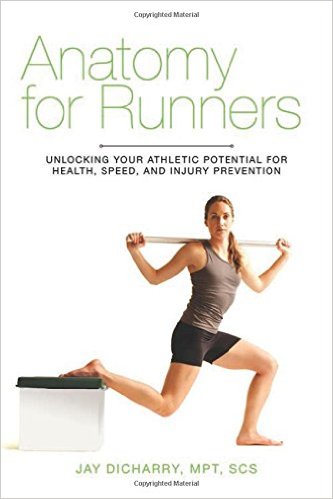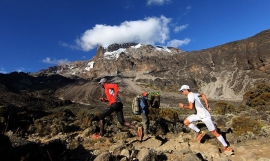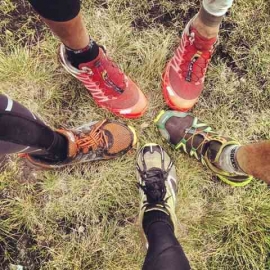
Paperback: 320 pages
Publisher: Skyhorse Publishing; 1 edition (August 1, 2012)
Author: Jay Dicharry
Language: English
ISBN-10: 1620871599
ISBN-13: 978-1620871591
Product Dimensions: 6 x 6.1 x 9 inches
==
Running has become more and more popular in recent years, with thousands of people entering marathons, buying new running shoes with the latest technology, and going for a daily jog, whether on the track or on a treadmill. Unfortunately, with running comes injuries, as a result of wrong information and improper training. Author Jay Dicharry was tired of getting the same treatments from doctors that didn’t heal his joint and muscle pain from running, so he decided to combine different fields of clinical care, biomechanical analysis, and coaching to help you avoid common injuries and become the best runner you can be.
Along with clear and thorough explanations of how running influences the body, and how the body influences your running, this book answers many of the common questions that athletes have: Do runners need to stretch? What is the best way to run? What causes injuries? Which shoes are best for running? Is running barefoot beneficial?
The mobility and stability tests will assess your form, and the corrective exercises, along with step-by-step photos, will improve your core and overall performance, so that you can train and run with confidence, knowing how to avoid injuries!
====
Editorial Reviews
Review
“The biggest challenge running coaches encounter is discovering the balance between maximizing workload while holding off injuries. Jay Dicharry presents years of knowledge and useful practical information in a format that's understandable. I am certain Anatomy for Runners is spot on because Jay has helped several of my athletes both remain healthy as well as get back to championship form.” (Jason Vigilante)
“This is the best resource on running biomechanics and injury prevention. The corrective exercises have become part of my training routine, improved my performance, and reduced my injuries.” (Alan Webb, American record holder in the mile)
“Running is a simple sport, right? But why does almost everyone get hurt? As Jay discovers in this valuable guide, the reason is an amazingly complex mix of anatomy, strength, forces, vectors, and footwear effects. Alas, after reading this book and feeling what running really is, you will rediscover and understand its simplicity . . . then you can throw the rest of the library away.” (Dr. Mark Cucuzzella)
About the Author
Jay Dicharry , MPT, SCS, is the Director of the SPEED Clinic and the Motion Analysis Lab at the University of Virginia. Originally from New Orleans, Jay received his Masters of Physical Therapy degree at Louisiana State University Medical Center. He is an instructor in the Sports Medicine program and Physical Medicine and Rehabilitation Residency at the University of Virginia. Jay is a Board Certified Sports Clinical Specialist, and a certified coach through both the United States Track and Field Association and the United States Cycling Federation. He is widely published in numerous professional journals on running gait and biomechanics, lectures nationally to clinicians and coaches on care of endurance athletes, conducts research on runners, and consults to individual, USA Track and Field and the US Air Force on athlete development. Jay has a competitive history in swimming, triathlon, cycling, and running events on both the local and national level, and has coached athletes from local standouts to national medalists. His passion is combining his personal, clinical, and research focus to help athletes achieve their full potential.
==
The best science and practicality without any spin. The author's experience and expertise becomes vivid through the way he describes complex biomechanics, properties of tissue healing, and neuromuscular adaptation through simplistic analogies. As a physical therapist with an intense interest in running injury prevention/treatment and improved running efficiency, this book is a must have. I would argue that this book is a must have even for the therapist who doesn't work with runners, but wants to learn how tissues in the body respond to mechanical stress and effective techniques to restore optimal mobility and stability and soft tissue function. The final 2 chapters of the book provide the reader with easy, effective self assessments and corrective exercises. Take home message from the book is that runners and coaches focus too much on the engine, but it's the chasis that breaks down and leads to injury and leaks in performance. Currently using this book as a soft blueprint for establishing a running specific biomechanics assessment program.
发布于
跑步书籍百科
最新文章 BY 百科小组
- 完全跑步圣经 - 轻松持久跑,运动伤害OUT_著:维杰‧费德、戴夫‧艾伦;译:李依蓉_2015_跑步书籍第0810本_附简介总结|笔记摘录|PDF电子书下载
- 田径运动双语教程_申伟华_2007_跑步书籍系列_第0808本_附PDF电子书下载
- 田径运动教学大纲_俄罗斯苏维埃联邦社会主义共和国教育部编_人民教育出版社_1956_跑步书籍系列_第0807本_附PDF电子书下载
- 田径运动技术诊断与分析.刘生杰著.中国社会出版社.2011_跑步书籍系列_第0806本_附PDF电子书下载
- 田径教学 专题篇 配多媒体辅学课件.李鸿江主编.高等教育出版社.2012_跑步书籍系列_第0805本_附PDF电子书下载



